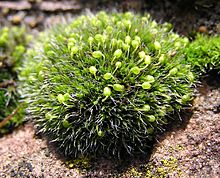Cryptogam




Acryptogam(scientific nameCryptogamae) is a plant (in the wide sense of the word) or a plant-like organism that reproduces byspores,without flowers orseeds.
Taxonomy
[edit]The nameCryptogamae(fromAncient Greekκρυπτός(kruptós)'hidden' andγαμέω(gaméō)'to marry') means "hidden reproduction", meaning non-seed bearing plants. Other names, such as "thallophytes","lower plants",and" spore plants "have occasionally been used.
As a group, Cryptogamae are paired with thePhanerogamaeor Spermatophyta, theseed plants.At one time, the cryptogams were formally recognised as a group within the plant kingdom. In his system for classification of all known plants and animals,Carl Linnaeus(1707–1778) divided the plant kingdom into 24classes,[1]one of which was the "Cryptogamia". This included all plants withconcealedreproductive organs. He divided Cryptogamia into four orders:Algae,Musci (bryophytes), Filices (ferns), andfungi,[2]but it had also traditionally includedslime molds,andCyanophyta.[3]The classification is now deprecated inLinnaean taxonomy.Cryptogams have been classified into three sub-kingdoms:Thallophyta,Bryophyta,andPteridophyta.[3]
Not all cryptogams are treated as part of theplantkingdom today; the fungi, in particular, are a separate kingdom, more closely related toanimalsthan plants, whileblue-green algaeare aphylumofbacteria.Therefore, in contemporaryplant systematics,"Cryptogamae" is not a taxonomically coherent group, but ispolyphyletic.However, the names of all cryptogams are regulated by theInternational Code of Nomenclature for algae, fungi, and plants.
In human culture
[edit]Anapocryphalstory: it is said that duringWorld War II,the BritishGovernment Code and Cypher SchoolrecruitedGeoffrey Tandy,a marine biologist expert in cryptogams, toStation X, Bletchley Park,when someone confused these withcryptograms.[4][5][6]However, the story is a myth; though Tandy did indeed work at Bletchley, he was not recruited by mistake. At the time the field of cryptography was very new, and so it was typical to hire those with education and expertise in other fields.[7]
References
[edit]- ^Dixon, P. S. (1973).Biology of the Rhodophyta.Oliver and Boyd,Edinburgh.ISBN0-05-002485-X.
- ^"Cryptogams".Royal Botanic Garden, Edinburgh.Archived fromthe originalon 2007-11-18.Retrieved2007-07-02.
- ^abSmith, Gilbert M.(1938).Cryptogamic Botany, Vol. 1.McGraw-Hill.
- ^Smithies, Sandy (19 January 1999)."Television Tuesday Watching brief".The Guardian.Retrieved23 July2015.
- ^Davies, Mike (20 January 1999). "Cracking the code at last ofStation X".Birmingham Post.
- ^Hanks, Robert (20 January 1999). "Television Review".The Independent.
- ^Knighton, Andrew (2018-05-27)."The Debunked Yet Interesting Myth About How Seaweed Apparently Helped Break the Enigma Code".warhistoryonline.Retrieved2024-05-13.
External links
[edit]- .Encyclopædia Britannica.Vol. 1 (11th ed.). 1911. p. 155.
